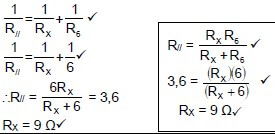PHYSICAL SCIENCES PHYSICS PAPER 1 GRADE 12 MEMORANDUM - AMENDED SENIOR CERTIFICATE EXAM PAST PAPERS AND MEMOS MAY/JUNE 2016
Share via Whatsapp Join our WhatsApp Group Join our Telegram GroupPhysical Sciences (Physics)
Paper One (P1)
Grade 12
Amended Senior Certificate Exam Past Papers And Memos
May/june 2016
Memorandum
QUESTION 1
1.1 A✓✓ (2)
1.2 B✓✓ (2)
1.3 D✓✓ (2)
1.4 C✓✓ (2)
1.5 B✓✓ (2)
1.6 B✓✓ (2)
1.7 A✓✓ (2)
1.8 D✓✓ (2)
1.9 C✓✓ (2)
1.10 D✓✓ (2)
[20]
QUESTION 2
2.1 A body will remain in its state of rest or motion at constant velocity ✔unless a resultant/net force✔ acts on it.
OR
Every body continues in its state of rest or of uniform motion in a straight line ✔unless a resultant/net force ✔acts on it. (2)
2.2 0 (N)✔/zero/nul (newton)
NOTE: No penalisation if the unit is omitted (1)
2.3
Accepted labels | |
w | Fg / Fw / weight / mg / gravitational force |
T | FT / tension |
15 N | Fa / F15N / Fapplied / Ft / Ftoegepas / F |
Accept
OR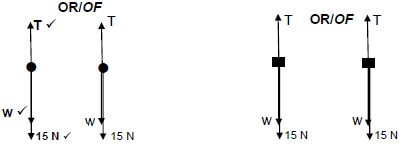 (3)
(3)
Notes
|
2.4 (7)
2 kg block 10 kg block |
NOTE:L |
Massless string approximation/Systems approach (4/7) |
2.5 Smaller than ✔ (1)
2.6 Remains the same ✔ - The coefficient of kinetic friction is independent of the (apparent microscopic) surface areas in contact. ✔
OR
The coefficient of kinetic friction depends only on the type of materials used✔ (2)
[16]
QUESTION 3
3.1 An object upon which the only force✔ acting is the force of gravity.✔
ACCEPT
An object that falls freely ✔with an acceleration of (g) 9,8 m∙s-2 ✔
An object that is launched ✔(or synonyms) with an initial velocity under the influence of the force of gravity.✔ (2)
3.2.1 (4)
OPTION 1 | |
Upward positive vf = vi + aΔt ✔ | Downward positive vf = vi + aΔt ✔ |
OPTION 2 | |
Upward positive vf = vi + aΔt ✔ | Downward positive vf = vi + aΔt ✔ |
OPTION 3 | |
Upward positive Δy = viΔt + ½ aΔt2✔ | Downward positive Δy = viΔt + ½ aΔt2✔ |
OPTION 4 | |
Upward positive Fnet∆t = ∆p = (mvf – mvi)✔ | Downward positive Fnet∆t = ∆p = (mvf – mvi)✔ |
OPTION 5 | |
Upward positive From top to bottom | Downward positive From top to bottom |
3.2.2
POSITIVE MARKING FROM QUESTION 3.2.1 |
OPTION 1 Δy = viΔt + ½ aΔt2 ✔ OR POSITIVE MARKING FROM QUESTIONS 3.2.1 Δy = viΔt + ½ aΔt2 ✔ |
OPTION 2 vf = vi + aΔt Δy = viΔt + ½ aΔt2 ✔ OR Δy = vf + vi Δt✔ OR vf2 = vi2 + 2aΔx ✔ | Downward positive vf = vi + aΔt Δy = viΔt + ½ aΔt2✔ OR Δy = vf + vi Δt✔ OR/OF vf2 = vi2 + 2aΔx ✔ |
OPTION 3 vf = vi + aΔt Δy = vf + vi Δt✔ | vf = vi + aΔt Δy = vf + vi Δt✔ Distance = |Δy| = 25,12 m✔ |
OPTION 4 Δy = viΔt + ½ Δt2 ✔ | Downward positive Δy = viΔt + ½ Δt2✔ |
(4)
3.3 (4)
POSITIVE MARKING FROM QUESTION 3.2.1 | |
Upward positive Δy = viΔt + ½ aΔt2✔ | Downward positive Δy = viΔt + ½ aΔt2✔ 50✔= vi (4,12) + [½ (9,8)(4,12)2]✔ vi = - 8,05 m∙s-1 speed/spoed = 8,05 m∙s-1✔ |
3.4
POSITIVE MARKING FROM QUESTIONS 3.2.1 AND 3.2.2 |

Criteria | Marks |
Correct shape of A | ✔ |
Correct shape of Graph B parallel to A below A | ✔ |
Time at which both A and B reach the ground (6,12 s) | ✔ |
Time for A to reach the maximum height (3,06 s) shown | ✔ |
NOTE :
Do not penalise if velocities are not indicated
3.4
POSITIVE MARKING FROM QUESTIONS 3.2.1 AND 3.2.2 |
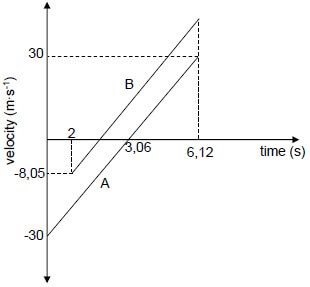
Criteria | Marks |
Correct shape of A | ✔ |
Correct shape of Graph B parallel to A above A | ✔ |
Time at which both A and B reach the ground (6,12 s) | ✔ |
Time for A to reach the maximum height (3,06 s) shown | ✔ |
(4)
[18]
QUESTION 4
4.1 The total (linear) momentum of an isolated (closed) system ✔is constant (is conserved) ✔
OR
In an isolated (closed) system, the total (linear) momentum ✔before collision is equal to the total linear momentum after collision. ✔ (2)
4.2.1 (4)
∑pi = ∑pf OR Δp5kg = -Δp3kg ✔ |
4.2.2 (4)
OPTION 1 Fnet∆t = ∆p = (pf – pi) = (mvf – mvi) ✔ | |
OPTION 2 = m (vf- vi)✔ = 8 (0 - 2,5) ✔= - 66,67 N | OPTION 3 |
OPTION 4 Wnet = ΔEk Fnet (Vf + Vi) Δt cos 180º = ½m(Vf2 - Vi2)✔ |
[10]
QUESTION 5
5.1 The total mechanical energy in an isolated (closed) system ✔remains constant (is conserved). ✔
NOTE
If total or isolated/closed is omitted (max: 1/2 ) (2)
5.2.1 (3)
W = F∆x cosθ✔ |
5.2.2 (5)
OPTION1 |
OPTION 2 Wnet = ΔEK |
5.3 (4)
F = w// + f Pave = Fvave ✔ |
[14]
QUESTION 6
6.1 X ✓ (1)
6.2 As ambulance approaches the hospital the waves are compressed✓or wavelengths are shorter. Since the speed of sound is constant✓ the observed frequency must increase✓. Therefore the hospital must be located on the side of X (from v = fλ)
OR
The number of wave fronts per second reaching the observer are more at X✓✓. For the same constant speed, this means that the observed frequency increases ✓therefore the hospital must be located on the side of X. (from v = fλ) (3)
6.3 (5)
| fL= V ± VL fS OR FL = V FS✔ V ± VS V - VS fL = 304 ✔ (400)✔ (340 -✔ 30) fL = 438,71 Hz✔ NOTE: |
6.4 (3)
v = fλ✔ |
[12]
QUESTION 7
7.1 (3)
n = Q / e ✓ | n = Q / e ✓ |
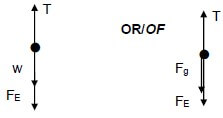
7.2 (3)
Accepted label | |
w | Fg/Fw/weight/mg/gravitational force |
T | FT/tension Fs/spanning |
FE | Felectrostatic/FQ1Q2 /Coulomb force/F |
7.3 (5)
Fnet = 0 ACCEPT FE = wQ2 ✔ |
[11]
QUESTION 8
8.1 The (electrostatic) force experienced by a unit positive charge (placed at that point).✔✔
NOTE:
If the words “unit positive” is omitted (max 1/2) (2)
8.2 (2) 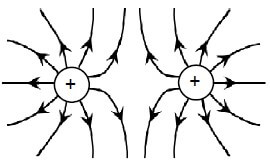
8.3 (3)
Guideline for allocating marks | ||
Lines must not cross / Lines must touch the spheres but not enter spheres | ✔ | |
Arrows point outwards | ✔ | |
Correct shape | ✔ | |
(5) ↓
E =kQ ✔ EQ1X = EQ2X ✔For equating equations 5,477 = 6,708 |
[10]
QUESTION 9
9.1.1 (3)
OPTION 1 P = V2 / R✔ R = 36 Ω✔ | OPTION 2 P = VI V = IR✔ | OPTION 3 P = V I P = I2 R ✔ |
9.1.2 Increase✔ (1)
9.1.3 No change✔ - Same potential difference✔ (and resistance) (2)
9.2.1 (4)
V = IR ✔ V”lost” = Ir OR ε= I(R + r) |
9.2.2 Work done ✔in moving a unit charge ✔ through a cell.
ACCEPT
Energy transferred per unit charge/ Work done in moving in 1 C of charge. (2)
9.2.3
OPTION 1 V|| = I6R6 Vx = IRx✔ OR V = IR |
OPTION 2 V”lost” = Ir V|| = IpRp
RX = 9 Ω✔ |
(5)
[17]
QUESTION 10
10.1.1 a to b ✔ (1)
10.1.2 Fleming's left hand rule /Left hand motor rule✔
ACCEPT
Right hand rule (1)
10.1.3 Split rings /commutator ✔ (1)
10.2.1 Mechanical/Kinetic energy to electrical energy. ✔✔ (2 or/of 0) (2)
10.2.2 (5)
OPTION 1 Vrms = Vmax✔ I = V/R✔ = 304,06/400 ✔ | OPTION 2 Vmax = ImaxR ✔ √2 = 1,075 ✔ √2 = 0,76 A✔ |
OPTION 3 Vrms = Vmax✔ | OPTION 4 Vrms = Vmax✔ Pave = I2rmsR✔ 231,13 = I2rms (400) ✔ Irms = 0,76 A✔ |
[10]
QUESTION 11
11.1.1 It tells us that light has a particle nature.✔ (1)
11.1.2 Remain the same. ✔ - For the same colour/ frequency/wavelength the energy of the photons will be the same✔. (The brightness causes more electrons to be released, but they will have the same maximum kinetic energy.)
OR
Intensity only affects the number of ejected photo-electrons and not the maximum kinetic energy or maximum speed of the ejected photo-electrons
OR
Maximum kinetic energy of ejected photo-electrons is independent of intensity of radiation (2)
11.1.3 (5)
E = W0 + Ek |
11.2 Q✓ and/en S ✓ - Emission spectra occur when excited atoms /electrons drop from higher energy levels to lower energy levels. ✓✓ (4)
[12]
TOTAL: 150
